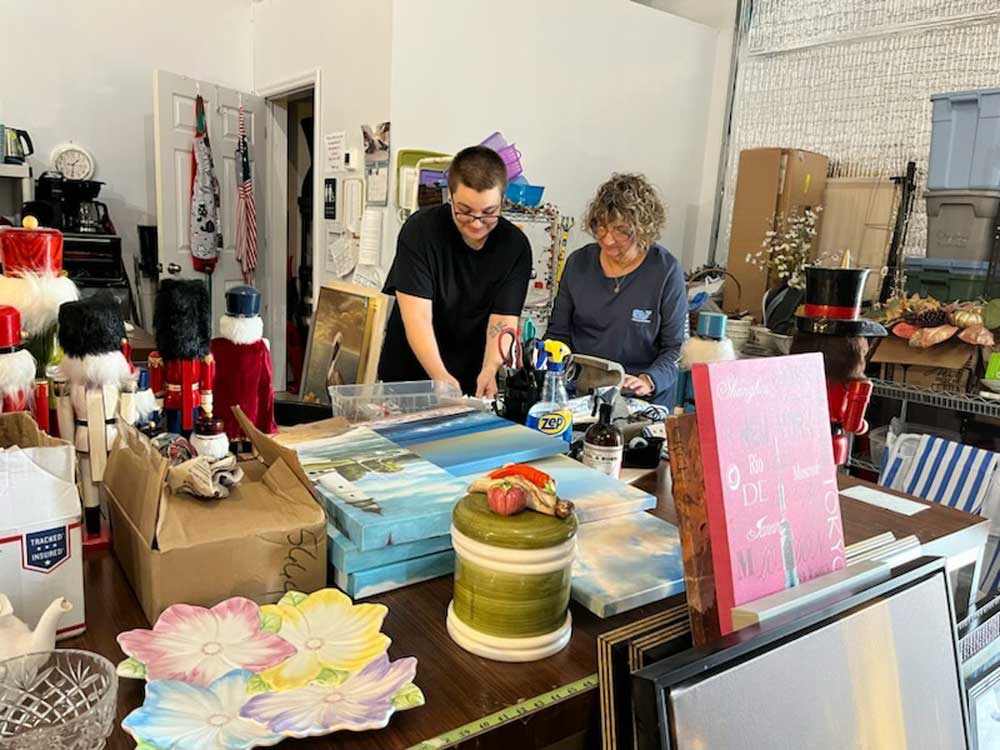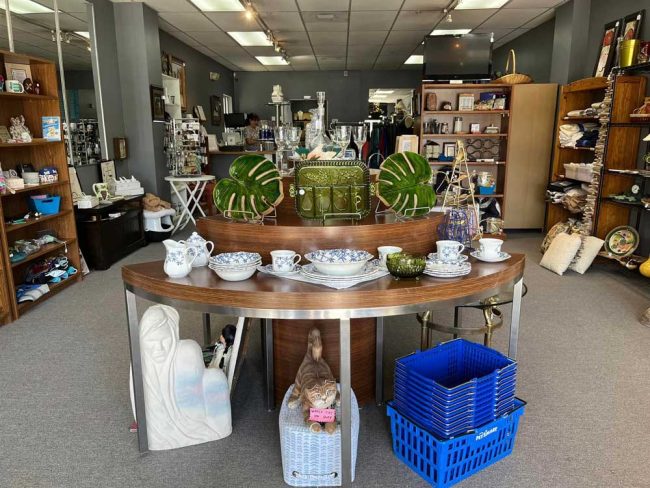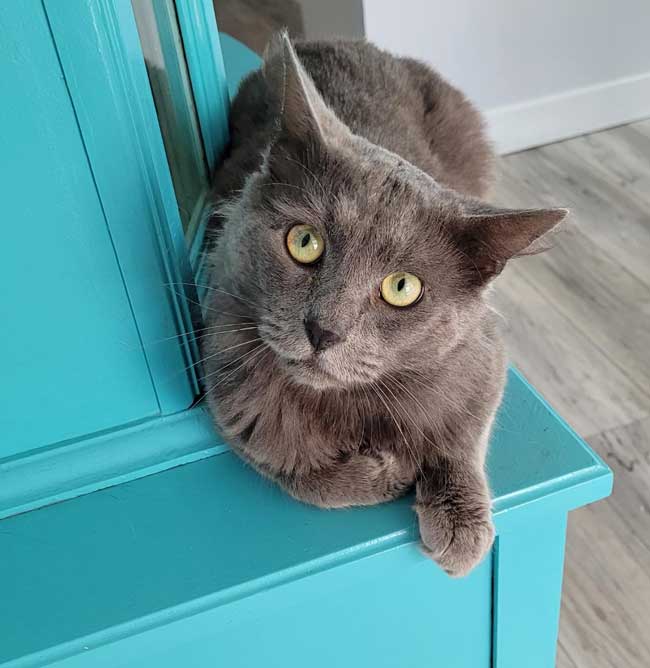
The relief mixed with excitement was very evident in Jessica Myers’ voice.
The Executive Director of Community Cats of Palm Coast (CCOPC), the non-profit cat rescue operation that forged the city’s trap-neuter-release program, has had a rough few years, filled with court appearances and fights with her previous landlord at Alamo Business Center in Palm Coast.
But now, all that is behind Myers and her team. They’re set for the grand opening of their new location at City Marketplace this Saturday from 1 to 4 p.m.
Community Cats of Palm Coast, which operates the adoption shelter at 160 Cypress Point Parkway, Suite B-110, and a thrift store there at Suite C-101 (upstairs and downstairs), has been in business for 10 years, helping rescue, trap and deal with feline problems in the area. Myers said they’ve rescued and helped more than 2,500 cats in the past decade. They are a separate entity from Flagler Humane Society, though Myers said they do a lot of rescuing and trapping for the society.
“We’re so excited to have people find us and learn exactly what we do,” Myers said. “Being located in this great space where everyone can see us will be great, it will make us even more a part of the community.”
The thrift store helps generate revenue. It sells clothing, kitchen items, small appliances, linens, shoes, some electronics and flatscreen televisions, among other items.
For the last few years Myers and Community Cats have been embroiled in disputes with their previous landlord, some of which resulted in court appearances. The dispute led to the departure from the previous location.
Community Cats can house 15 to 20 cats at the new location, and also fosters approximately 60 others with families in and around Flagler County.

The new site “will be a free roam adoption center,” Myers said. “That’s a plus because people can interact with the cats, spend some time with them, and see if there’s a cat that would be a good fit.” It’s not one way: Cats are known to be particular about who they choose.
Myers sought to clear up some misconceptions about Community Cats, its funding, and how animal control works in Flagler County and its towns. The cities of Bunnell and Flagler Beach have contracts with the Flagler Humane Society (FHS), also a non-profit, but Palm Coast does not.
Palm Coast has its own animal control services division, with three officers, operating within the Code Enforcement Department. But the city only deal with nuisance animals. Flagler County has an Animal Services Department funded by the county commission. It works with the Humane Society to shelter stray animals. FHS receives money from the county each time they take in a stray animal. This year’s budget awards $276,000 to the Humane Society, up from $211,000 in 2020.
However, Community Cats is the only group in Flagler County that does TNR. Yet it receives no money from either the county or Palm Coast government.
“Flagler County has said we’re welcome to bid on the entire contract to handle TNR, but that would mean also dealing with dogs, which we’re not equipped to do right now,” Myers said. “And we are often called to help with TNR by the Humane Society, and we get no funding for doing that as well.”
There is a “huge” overpopulation problem with cats in Flagler County, Myers said, partly because it’s one of the few counties in Florida that does not have a dedicated, active TNR program, leaving it to organizations like hers to handle.
Myers said the rent and expenses on their new locations for the thrift store and adoption centers is around $7,000 per month (compared to $4,500 at the previous location, according to court documents), and that Community Cats’s annual revenue is just under $50,000 per year (All of CCOPC’s staff are volunteers). In comparison, Flagler Humane Society had $1.5 million in revenue in 2020, according to that year’s tax filing.
“It’s frustrating to us sometimes because the public thinks that FHS is the county, when they’re the same as us,” Myers said.
As far as what people can expect if they’re just discovering Community Cats, Myers added that potential adopters of the cats go through a process of an initial interview, and a rigorous screening and vetting process.
The thrift store acts as a fundraising tool for the adoption center, Myers explained, and they’re hoping in their new site CCOPC can hold more adoption events and public gatherings.
“We’re excited to show the community all the services we offer and have more people discover what we’re about,” Myers said.
–Michael Lewis for FlaglerLive
![]()






























Kat says
Personally, I have a huge amount of admiration/appreciation for the service that you provide to our community and its feline residents. I will be happy to patronize you in your new quarters!
Mtn. Man says
Great organization, we love our cat that we adopted from them . They are a very professional.
MeToo says
Is the current location 160 Cypress Pt Pkway?
Laurel says
Nearly all our stuff eventually ends up at Flagler Humane Thrift Shop, and we shop at Community Cats. TNR (Trap, Neuter, Release) is very important, and should be supported. I often see perfectly good items set out for trash. Donations to, and purchases from FHS and CC is a great way to recycle goods. Do it!
Debbie says
Love the compassion for Cats and I was an owner of a gift shop.
Will look you up again when we are moved in.
Peter says
Community cats is a group that does not respect the local ecosystem and the native animals that live with in it. TNR is not an effective form of management. These cats kill native birds, snakes, small reptiles, rodents and most importantly out compete the native cat The Florida bobcat for food resources. We have a native “fur baby” living in the woods already. We don’t need to be feeding more. The city and the like should do away with programs that don’t lend themselves to credible wildlife management. And put our local population of native animals at risk when we already are losing more and more land everyday to development and real estate in the area. All cats that are captured should remain captured and not be re released. It’s honestly amazing someone has challenged this in court yet. Because there are many other examples where releasing non native animals have and can result in citations.
can'tfoolme says
Don’t mess with God’s food chain, Peter. I’m sure He knew what He was doing when He assigned each species certain instincts and diets and am sure that the bobcat’s are the same as the homeless cats you dislike. The volunteers of C0mmunity Cats provide an invaluable service in controlling the population of homeless cats, the spread of rabies, lessening the impact on wildlife by feeding them, and finding permanent or foster homes for these (as yet) unloved future pets. Volunteer and you can help save the wildlife about which you are concerned and at the same time help another of God’s creatures.
Jessica Myers says
IF you were truly educated on the subject you would learn that what we do is not what you are describing. Why not take the time to actually do the research before spewing nonsense. The truth is an altered cat that is well fed in a controlled situation is ABSOLUTELY NO THREAT to wildlife. I will admit there is no perfect solution to a problem that HUMANS in this community created. There must be a solution. Comments such as yours, I assure you are not part of a solution. There needs to be a system in place that works supported by our local municipalities. It is only by coming together can we make any real change. The issues that create unwanted stray cats need to be dealt with instead of being ignored. If local government would actually enforce their codes and laws related to unaltered and free roaming cats maybe we could get somewhere. You are angry at the wrong group. We are the last one to want to see ANY domestic cat live a life outdoors! If you do the research you will find that CCOPC has attempted many times to enact change on the local level and have gotten nowhere. Possibly because many, like you, never take the time to do anything other than place blame and point fingers rather than joining with those of us in this community that are trying to actually do something about it!
If you ever feel the desire to actually learn the truth about how to resolve this never ending cycle of homeless cats in our community, I would be happy to meet with you.
Jessica Myers, Executive Director, CCOPC
Ken says
So the release part of (trap, neuter, release) isn’t that you release the neutered cats back into the wild? Release means they are well fed and maintained in a controlled environment?
Jessica Myers says
That is correct! First let me say that TNR is NOT the best way to deal with this situation. Unfortunately to correctly deal with it means to deter it to begin with! This can only be done with the help of local government. Stricter ownership policies and enforcement! Since time travel hasn’t been perfected yet, we can only do the best we can. Having said that, our organization only releases back to areas where there are established feeders. This is ALWAYS on private property! Never to the wild! If a cat can not be returned to this situation it is held until a “barn” placement can be obtained. If you really think about it…any true cat lover does not want to put a cat in any situation where it is not cared for. We (CCOPC) do not want any domestic cat to have to hunt for food or be hunted either. The problem is getting people like you (not being said in a negative way) to work WITH us and not against us. We all want you the same thing. The only difference is we choose not to mass euthanize as a solution.
Laurel says
Ken: I know of eight cats, from North Carolina, who were dumped in Flagler Beach. Three were killed by cars, almost instantly, and others have dwindled, most likely by cars as well. All had been spayed as indicated by clipped ears. We adopted one of them, and she had a chip, so that’s how we learned of their history and their origination. Two are left (our indoor cat being a third from that group) and remain outdoor cats with the care of neighbors, and Community Cats has helped with food.
Ms. Meyers is incorrect, however, about a cat’s nature. They will continue to hunt, which is why they are so successful at surviving as a species. Spayed cats are not as destructive, as Peter commented, as a cat with a full belly is more likely to have a nice siesta! The main thing is that they will not reproduce, and they have a shorter life span. This is much better than whole cats reproducing and hunting for all meals and training offspring, and it’s much better than just keep killing cats.
I have a good friend in the business, and no matter what she does in regards to education, people continue to let their cats outside to continue to produce unwanted kittens. It’s very frustrating work, trying to get people to do the right thing for their pets. Community Cats is trying to do something about it, and are saving these wonderful creatures. They deserve help.
Celia Pugliese says
Community Cats does a great work trying to control the feral population. I firmly believe that also the feral population is controlled by wildlife as sadly some bobcats been seeing carrying (sadly) dead feral’s in their mouths into the woods. Many free roaming domestic cats have been disappearing lately…as owners should not let them roam free if would really love them. I adopted one of those feral kitties that showed very thirsty in my driveway in a hot summer day looking for water on the puddles made b y me washing my car, years ago…I found out later in the day its sibling identical looking killed by traffic in Clubhouse Drive and afterwards run over by golf course mowers…to which I filed complaint. I gave shelter and food to Kitti so small he was, that I needed to wait till old enough to take him for neutering, vaccinations and deworming. Then he never was allowed out of my patio lanai…where he lives happily and safe ever after. I tried for him to be adopted but no luck then is one more family member now. Lately he lost his best buddy my beloved rescued Jack Russell 15.5 years old ” Lucky” (my best companion too) so he has become very close to me given the unexpected absence. So to Peter, this is one feral bitter/sweet story maybe to soften your thoughts about volunteers for ferals as is not their great work what should be criticized but the negligence and cruelty of those owners discarding their pets cats or leaving them behind when they move away!
Laurel says
Celia: We lost our old tabby last year. We was just a month or two shy of being 22 years old! As you are well award, indoor cats live longer, healthier lives. Ours range from 16 to 22 years of age before passing.
Another danger to outdoor cats is coyotes. Coyotes are wildlife, but not indigenous to Florida. They should not be here. We know someone who spotted coyotes in Ormond Beach, so I’m certain they are around here as well.
jeffery seib says
My congratulations to Community Cats for hanging in there and giving the community another resource to help the so-called homeless cat population that we all can see is very numerous in Palm Coast. I say so-called because these animals didn’t just appear out of nowhere on our streets and wooded areas. somebody dumped them there in the first place. The problem is a human caused one, not animal caused. Domestic cats are not a native species of North America. Life is the ‘wild’ is extremely dangerous for these animals and there is a high mortality rate. I salute Community Cats for making this effort to help living things. Maybe we should all make an effort to help living things. Talk is cheap, actions speak louder than words.